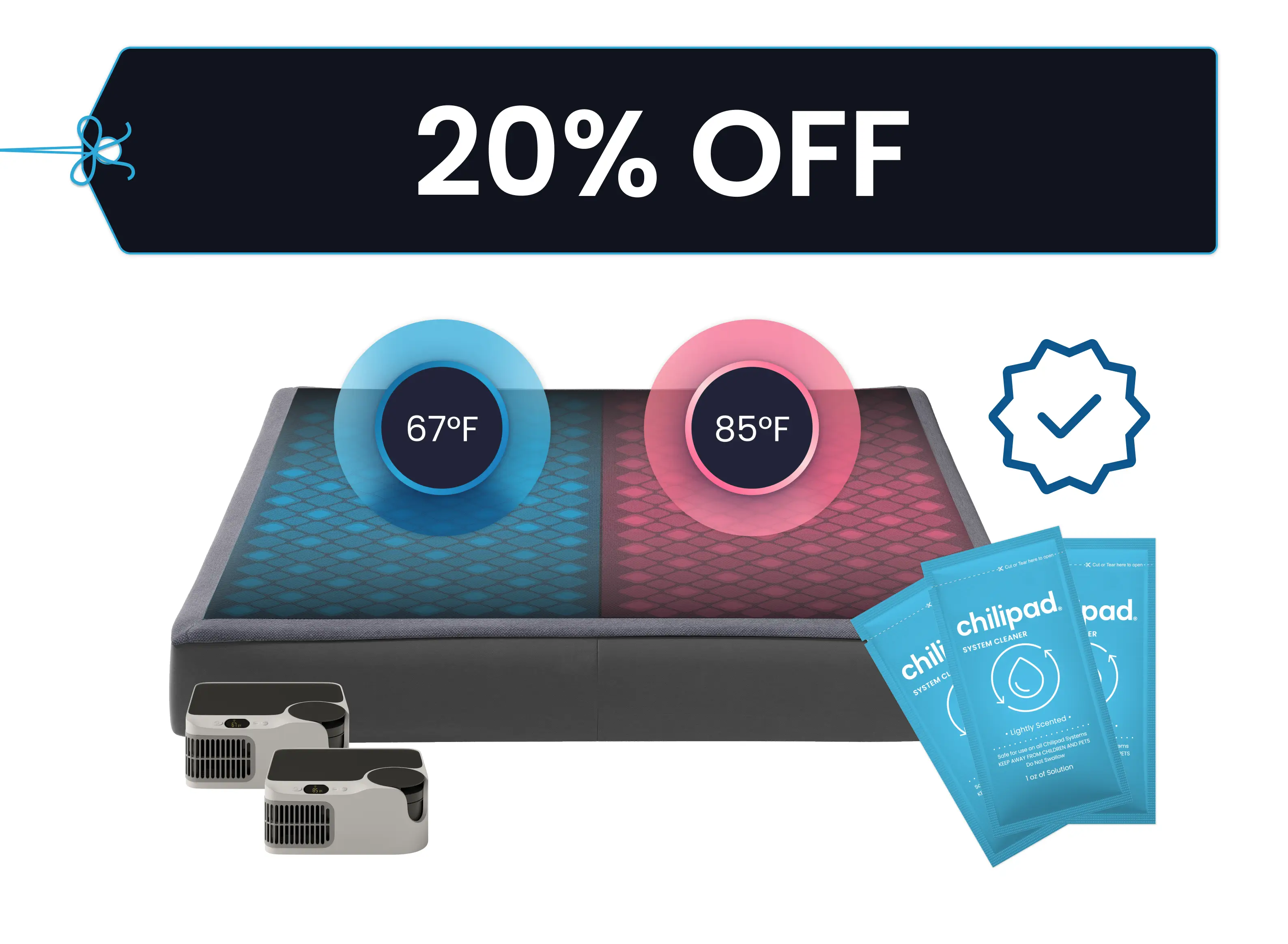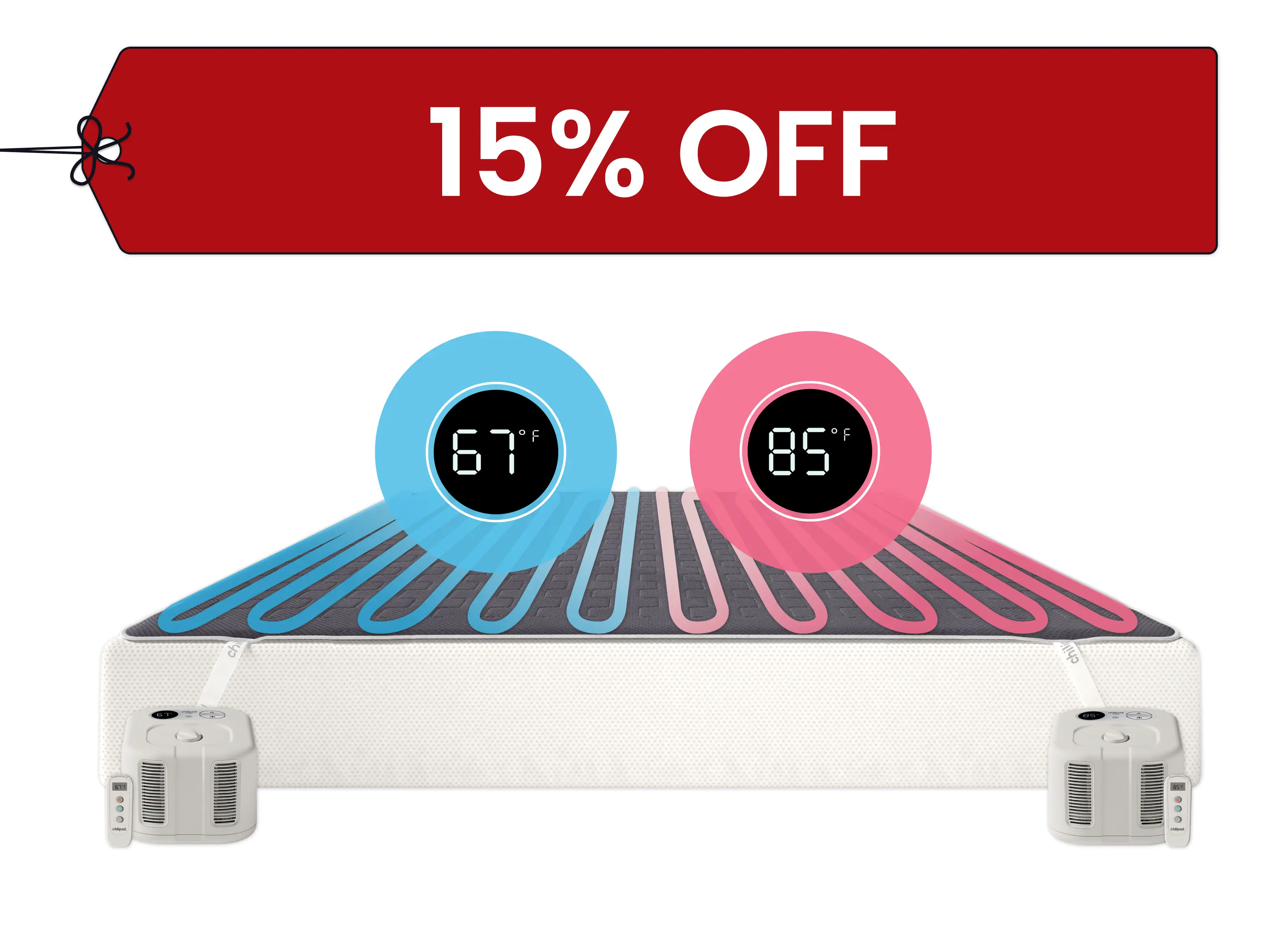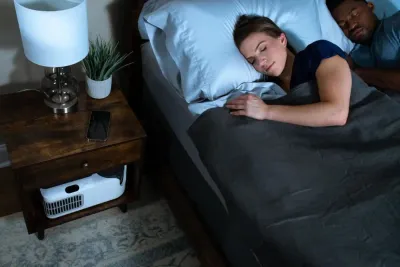Understanding Sleep Latency: Key Insights for Better Sleep Quality
Chilipad Editorial Team • Jul 24, 2025

Key Takeaways
Sleep latency is the amount of time it takes to fall asleep after getting into bed. For most adults, healthy sleep latency is between 10 and 20 minutes.
- Sleep latency measures how long it takes to fall asleep after getting into bed.
- A healthy sleep latency is typically under 20 minutes, signaling balanced sleep pressure and routine.
- Stress, caffeine, screen exposure, and excess heat can delay sleep onset and increase latency.
- Improving your sleep environment—especially reducing light, noise, and temperature—can help shorten sleep latency.
Ever find yourself staring at the ceiling for what feels like forever, wondering why sleep won’t come? Or maybe you crash the moment your head hits the pillow—and not in a good way. Both ends of that spectrum can tell you something important about your sleep health.
Sleep latency, also known as sleep onset latency, is the time it takes for you to fall asleep once you’ve settled in for the night. While the sweet spot is typically between 10 and 20 minutes, falling outside of that range could mean your body’s trying to tell you something, like you're not getting enough rest, you’re overly stressed, or you might have a sleep disorder.
Below, we’ll break down what sleep latency really means, what’s considered normal or not, how to track it, and how tools can help you take control of your sleep environment and finally get the rest you deserve.
Understanding Sleep Latency?
Sleep latency, also known as sleep onset latency, is the amount of time it takes you to fall asleep after turning off the lights and getting into bed. For most healthy adults, falling asleep takes about 10 to 20 minutes. If you’re falling asleep instantly or tossing and turning for an hour, it might be a sign that something’s wrong with your sleep habits or overall sleep health.
If you’re falling asleep in less than eight minutes, it could be a sign of excessive daytime sleepiness, often tied to sleep deprivation or conditions like narcolepsy. On the flip side, if it regularly takes more than 20 minutes to doze off, you might be dealing with insomnia or other sleep-related disruptions.
How Long or Short Should Sleep Latency Be?
The ideal sleep latency can vary based on individual factors, but general guidelines exist:
- Normal Range: For most adults, a sleep latency of 10 to 20 minutes is considered normal. This range indicates that the individual is likely experiencing a healthy sleep onset process.
- Short Sleep Latency: A sleep latency of less than 8 minutes may suggest excessive daytime sleepiness or sleep debt. This can be indicative of conditions such as narcolepsy, where individuals may nod off almost immediately due to overwhelming drowsiness.
- Prolonged Sleep Latency: A sleep latency of more than 20 minutes can indicate potential sleep issues, such as insomnia or anxiety. Individuals who experience prolonged sleep latency may struggle to relax and transition into sleep, which can lead to possible sleep disturbances and health issues.
Knowing where your sleep latency lands on the spectrum can give you valuable insight into your sleep health. It’s a useful checkpoint to identify potential issues that may need attention or lifestyle adjustments.
Ready to Fall Asleep Faster?
If falling asleep takes too long (or happens too fast), temperature might be to blame. The Chilipad utilizes smart cooling technology to help you relax and drift off—no more tossing and turning, or overheating.
Why is Sleep Latency Important?
Monitoring sleep latency is crucial for several reasons:
Indicator of Sleep Quality
Sleep latency is a vital indicator of how well you're actually sleeping. Taking too long to drift off to sleep can indicate poor sleep efficiency or insufficient rest, both of which can leave you feeling drained and irritable. Over time, consistently poor sleep latency has been linked to serious health risks, including heart disease, diabetes, obesity, and mental health issues like depression and anxiety.
Diagnosis of Sleep Disorders
Abnormal sleep latency can signal sleep disorders. For instance, a very short sleep latency may suggest conditions like narcolepsy, where individuals experience excessive daytime drowsiness and may fall asleep almost immediately. On the other hand, prolonged sleep latency can be associated with insomnia, anxiety, or chronic pain.
Impact on Daily Functioning
Sleep latency affects cognitive function, alertness, and overall quality of life. Individuals with excessive sleep latency may struggle with concentration, memory, and overall performance in daily tasks, which can affect their work and personal relationships.
Sleep Debt Assessment
Monitoring sleep latency can help identify sleep debt, which accumulates when a person does not get enough sleep. Chronic sleep debt can lead to significant health issues, making it essential to address sleep latency as part of a comprehensive sleep health strategy.
What Causes Long Sleep Latency
If it takes a long time to fall asleep, the issue is often tied to everyday habits and sleep conditions rather than a single problem.
- Stress and racing thoughts: Mental overload keeps your nervous system in alert mode, making it harder for your brain to switch into sleep.
- Late caffeine or nicotine: Stimulants consumed too late in the day can delay sleep onset, even if you feel tired.
- Screen use before bed: Bright screens stimulate the brain and interfere with melatonin, pushing sleep further out.
- Sleeping too hot: When your body cannot cool down, the natural signal to fall asleep gets delayed.
- Inconsistent sleep schedule: Going to bed and waking up at different times confuses your internal clock and slows sleep onset.
Addressing even one of these triggers can help shorten sleep latency and make falling asleep feel more natural again.
Sleep Latency Tests
When sleep disorders are suspected, healthcare providers may recommend specific tests to measure sleep latency. The following are common tests used to assess sleep latency:
Multiple Sleep Latency Test (MSLT)
This is a go-to test for measuring daytime sleepiness. It works by giving you several chances to take short naps, usually every two hours, while tracking how quickly you fall asleep each time. For most healthy people, falling asleep in about 10 minutes is a normal time.
But if you’re out in under eight minutes, especially during the day, it could be a sign of narcolepsy. The MSLT test involves taking a total of five daytime naps scheduled two hours intervals. Discover the different types of naps.
This Multiple Sleep Latency Test helps doctors diagnose sleep disorders like narcolepsy and idiopathic hypersomnia by providing clear, data-backed insight into how easily you drift off in a controlled setting.
Maintenance of Wakefulness Test (MWT)
This sleep test checks how well you can stay awake when you’re supposed to. In a quiet, controlled setting, you’re asked to stay alert for as long as you can—no dozing off allowed. On average, people can last about 30 minutes. If you drift off in under eight minutes, it’s a red flag for excessive daytime sleepiness and could point to an underlying sleep disorder.
This Maintenance of Wakefulness Test is especially helpful for evaluating how alert someone can remain in situations where staying awake is critical, like driving or working in safety-sensitive roles.
Polysomnography (PSG)
Polysomnography is the gold standard for sleep research. It’s an overnight sleep test that tracks everything from brain waves and heart rate, monitors sleep cycles, to breathing and movement while you sleep.
This deep dive into your sleep patterns helps spot issues like sleep apnea and shows how quickly you cycle through different sleep stages, including REM sleep.
PSG gives a full picture of your sleep architecture and is key for diagnosing or ruling out a wide range of sleep disorders—all while you’re catching Zs.
Benefits of Using the Sleep Tracker
Here are just a few benefits of tracking your sleep that can make a real difference, because every sleeper is unique, and your data should work for you:
Improved Sleep Quality
By tracking sleep latency and other key metrics, users can identify what’s holding them back and make meaningful changes. It’s especially helpful for anyone dealing with sleep disorders or ongoing sleep struggles, because better data means better rest.
Health Monitoring
The tracker keeps an eye on heart rate variability (HRV) and resting heart rate, giving you a window into your stress levels and overall fitness. It’s the kind of intel that helps you stay ahead of your health game.
Convenience
The non-wearable design lets you sleep naturally—no straps, no gadgets, no distractions. Just pure, uninterrupted sleep, the way it’s meant to be.
When to Contact Your Doctor
If falling asleep feels like a daily struggle—or if you're knocking out way too fast—it might be time to loop in your doctor. Here are some signs to watch for:
- You’re always tossing and turning: If it regularly takes more than 20 minutes, you could be dealing with insomnia or another sleep disorder.
- You're too sleepy during the day: Dozing off during meetings or needing naps just to function? Falling asleep in under eight minutes might point to narcolepsy or another underlying issue.
- It’s messing with your daily life: When sleep struggles start impacting your job, classes, or social life, it’s worth getting checked out. Poor sleep can drag down your mood and focus.
- You’re noticing other symptoms: Loud snoring, gasping for air, or weird nighttime movements could signal sleep apnea or other sleep conditions that need medical attention.
- Your mental health is taking a hit: If sleep problems come with anxiety, depression, or other mental health changes, don’t wait—addressing both together can make a big difference.
Sleep is essential, not optional. If your body is waving red flags, it’s time to listen.
Final Thought
Sleep latency, the time it takes you to drift into sleep, is more than just a stat. It’s a sneak peek into your sleep quality and overall health status. Whether you’re lights-out in seconds or staring at the ceiling for ages, both extremes can signal something’s off. A recent systematic review found the normal sleep latency for adults lands around 11.7 minutes.
Tests like the MSLT, MWT, and PSG help get to the bottom of what’s going on by giving clear, data-driven insights. And if your sleep latency consistently seems off, it’s a smart move to talk to a healthcare provider.
Sleep Latency Frequently Asked Questions
What Is Sleep Latency and Why Does It Matter?
Sleep latency is the time it takes to transition from full wakefulness to sleep. Ideally, this takes about 10–20 minutes. Too fast or too slow can be a sign that something’s off with your sleep health.
What Can Cause Long Sleep Latency?
Struggling to fall asleep could be linked to:
- Stress
- Screen time
- Caffeine
- Irregular sleep schedules
- Underlying sleep disorders like insomnia
How Can I Reduce My Sleep Latency?
Try these science-backed strategies to fall asleep faster:
- Stick to a consistent sleep schedule
- Avoid screens at least an hour before bed
- Cut back on caffeine in the afternoon
- Make your bedroom cool, dark, and quiet
- Use relaxation techniques like deep breathing or meditation
Is Low Sleep Latency Bad?
Falling asleep too fast, like in under 5 minutes is often a sign you’re running on empty. Ideally, it should take 10–20 minutes to fall asleep. If fall asleep instantly, your body could be making up for sleep debt.
Is long sleep latency a sign of insomnia?
It can be, especially if difficulty falling asleep happens several nights per week and impacts daytime energy.
Does sleeping hot increase sleep latency?
Yes. Overheating can delay the body’s natural cooling process needed to fall asleep.









